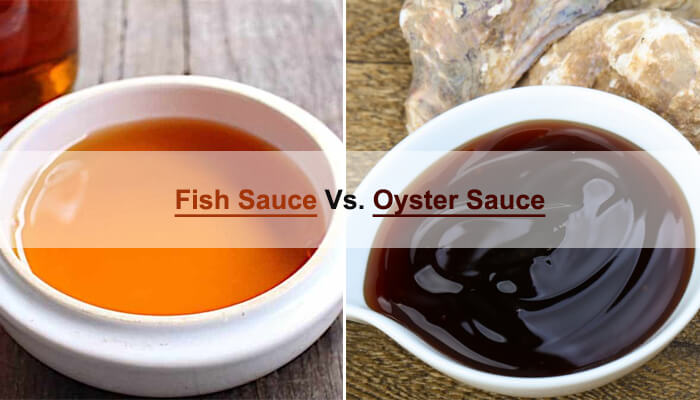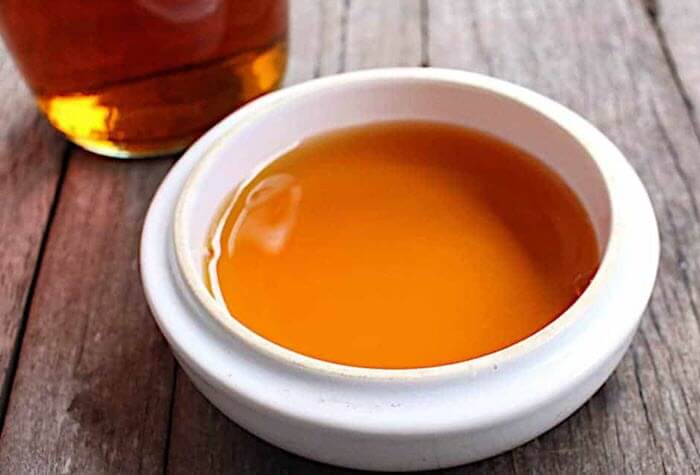10-Second Summary
Fish sauce and oyster sauce are both delicious additions to certain seafood dishes, but they are not the same thing.
Fish sauce is a simpler condiment whose main ingredient is fermented fish. Oyster sauce, as the name implies, has an oyster juice base, giving it a very different taste.
Let’s take a deeper look at how these two sauces are different, as well as how you can use them to spice up your own dishes.
Table Of Contents
What is Fish Sauce?
Most comparable to soy sauce in look and texture, fish sauce has a reddish color and thin consistency. It is just slightly denser than water and is very salty, in addition to having a trademark “fishy” flavor.
It has a savoriness that can be classified as “umami,” a word most often used to describe soups and broths.
Preparation Process
The preparation process for fish sauce begins with fish or small crustaceans called krill. These are coated with salt and fermented, often for up to two years.
Once the sauce is made, it is added to dishes either during the cooking process or after it is complete.
How to Use
Fish sauce is a condiment typically used in East Asian, Southeast Asian, and some Mediterranean dishes. It can be used to add seasoning to soup or marinades or even as a dipping sauce on the side of a seafood platter.
What is Oyster Sauce?
Oyster sauce is often brought up in conversation with fish sauce, but it has its own distinct flavor and composition.
This sauce is made from caramelized oyster juice, sugar, salt, and a bit of soy sauce, the latter of which is thickened with cornstarch. This gives it a denser consistency than its fish sauce cousin, as well as a completely different taste and smell.
Preparation Process
The history of oyster sauce production began in the 1870s in China. Back then, oysters were boiled in iron basins for thirty minutes, then dried on a rack or over a fire. The water leftover in the basins was cooked down to a darker, thicker liquid, to which salt water or soy was then added.
Today, the production process has been sped up and simplified with modern machinery and involves the use of MSG, sugar, salt, and other more modern ingredients.
How to Use
Whereas saltiness is one of the main characteristics of fish sauce, oyster sauce’s saltiness is more subtle.
This sauce is also sweeter and darker, and can be used in meat dishes as well as seafood fare, and even in a noodle-based stir-fry. It is often used in Thai, Vietnamese, Chinese, and Khmer cuisine.
Fish Sauce vs. Oyster Sauce: What Makes Them Different?
So, as you can see, the answer to “is fish sauce the same as oyster sauce?” is a resounding “no.”
In spite of the fact that some people wonder if they are interchangeable, there is a huge difference between oyster sauce and fish sauce – in fact, there are many.
Here is a look at the biggest ones.
Fish Sauce Vs. Oyster Sauce | ||
Fish Sauce | Oyster Sauce | |
Ingredients | Fish and salt | Oysters, sugar, salt |
Flavor | Fishy, strong | Sweetened, mild |
Color | Reddish-brown | Dark brown |
Consistency | Thinner | Thicker |
Origin | Ancient China | China |
Uses | Marinades, soups, stir-fry | Marinades, stir-fry, BBQ |
Shelf Life | Up to 2 years | 18 to 24 months |
Ingredients
The ingredients list for fish sauce is quite short: fish (or krill) and salt. That’s about it.
Oyster sauce, on the other hand, includes many ingredients, starting with the juices of oysters. Sugar, salt (but much less than the fish sauce), and sometimes even caramel are used to give this condiment its flavor, which, as you might have already guessed, is entirely different from fish sauce.
Flavor
Due to the fact that the fish or krill used in fish sauce is salted and left to ferment for years, fish sauce has a very strong, very salty, very fishy flavor that is almost pungent.
Oyster sauce, instead, is sweeter thanks to the caramelization and added sugar, and is more comparable to a sweetened soy sauce.
Color
Fish sauce’s color palette is reddish-brown, while oyster sauce has a very dark brown, almost black hue. This makes it possible to tell them apart on sight alone, not just after tasting.
Consistency
In addition to all these other differences, there is also a huge difference in consistency between fish sauce and oyster sauce.
Fish sauce is much thinner and more watery. In comparison, the oyster sauce is thicker and denser due to the addition of cornstarch and the intentional thickening of the oyster juices via reduction during production.
FAQs About Fish Sauce and Oyster Sauce
Can you substitute fish sauce for oyster sauce?
You’d better not substitute fish sauce for oyster sauce.
The two have entirely different flavor compositions and consistencies, meaning that the use of one instead of the other would completely change the recipe you are using.
If you need to make a substitution,
- Fish sauce can usually be swapped out for soy sauce (especially if it contains minced anchovies to replace the fishiness it would be missing) or Worcestershire sauce.
- Oyster sauce can be best substituted with dark soy sauce with added brown sugar.
What do you use fish sauce for?
Fish sauce is used in many dishes, most often those hailing from Asia.
It can be used as a marinade or a salad dressing, or it can be added to soups, vegetables, or even pasta or chicken to give it an extra burst of flavor. Perhaps the most popular usage is in pad thai or stir fries.
Fish sauce vs. oyster sauce vs. hoisin sauce, what’s the difference?
Fish sauce and oyster sauce are both seafood-based sauces, with the former being saltier with an umami flavor and the latter being sweeter and thicker. Both are most often used in fish dishes of Asian (or occasionally European) origin.
Hoisin sauce, though, is most often used as a dipping sauce or a glaze for meat, although it, too, is sometimes used in stir fries. It is composed of ingredients like soybeans, red chili peppers, fennel, garlic, and sometimes vinegar and other spices, which gives it a one-of-a-kind taste.
Further reading: Hoisin Sauce vs Oyster Sauce
Final Thoughts
While both fish sauce and oyster sauce are culinary delights, they are definitely not the same thing. In fact, aside from the fact that they are both made from sea creatures, there are many more differences between them than similarities.
Both are worth a try, however, and luckily, it is easy to tell them apart from their consistency, color, and flavor, so you can know which one you are sampling.



